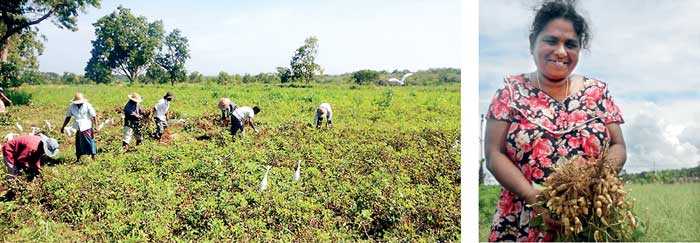Monday Nov 24, 2025
Monday Nov 24, 2025
Monday, 27 August 2018 00:00 - - {{hitsCtrl.values.hits}}

www.iaea.org: The year was 1993 when the groundnut variety Tissa, a product of mutation breeding, was released in Sri Lanka. As far as plant breeding is concerned, 25-year-old varieties are often ancient history – part of the past. Usually, new varieties are well received when they are released but as plant breeders continue to develop new improved varieties to meet new needs, the farming community also moves on. However, for the 1993 Tissa groundnut, it’s a different story. It remains by far the most popular groundnut variety among Sri Lankan farmers, who chose it for 80% of their groundnut plantings, consider it a cash crop and have seen their groundnut income increase 5%.
Sri Lanka started its mutation breeding program in the late 1960s with the help of the Joint FAO/IAEA Division that has continued to provide equipment and training. To breeders, Tissa was such a success that they now use it to breed new and even better groundnut varieties.
In Sri Lanka, where agriculture is the most important sector of the economy, nearly 82% of the population lives in rural areas and agriculture accounts for 30% of national employment. Although rice is by far the major crop for the country, about 5% of the farm families in Sri Lanka earn extra income growing and selling groundnuts. While not a main ingredient of Sri Lankan cuisine, groundnuts are often found in curries and fried rice, or roasted to be eaten as snacks. Farmers also benefit from a trend towards production of value-added groundnut products in the confection and snack industries, while still taking advantage of their traditional markets which include selling their groundnuts as an oil crop and as animal feed.
For the past 25 years, farmers in Sri Lanka have overwhelmingly chosen Tissa, a groundnut variety developed in the 1990s through irradiation of a Viet Nam groundnut. One element of this success undoubtedly stems from a survey that the breeders performed to determine what characteristics groundnut farmers and consumers would want from an improved groundnut variety. Based on input from farmers, they selected for disease resistant, drought tolerant and high-yield lines, and with the Tissa variety, they also selected a lower shell ratio and a 40% oil content. Tissa also has a short growing season, which means that it can be planted as an extra crop, often between rice seasons, with minimal land preparation and few inputs.
Screening mutants for desired traits
Working with the Joint FAO/IAEA Division, the Sri Lanka Department of Agriculture started mutation breeding in the late 1960s, using gamma irradiation to induce mutations. Nuclear techniques such as the use of gamma irradiation for inducing mutations in combination with related biotechnologies is an efficient and safe tool in breeding programmes for crop improvement and suitable to support efforts to enhance crop productivity. Enhancing crop productivity for sustainable food security is becoming an increasing issue in many countries as the effects of climate change and increasingly erratic weather events on agriculture are reducing the productivity of existing local varieties. Mutation breeding takes advantage of genetic variability for developing, for example, drought and disease-resistant varieties as well as myriad of other desired traits. Sri Lanka released its first mutant variety – a high yielding mutant rice – in 1971. Known as MI 127, it was widely adopted and contributed five percent of import savings of rice. This success was followed by other mutant varieties of sesame, rice, tomato and groundnut. The country has participated in many Coordinated Research Projects and national and regional technical cooperation projects, conducted with the Joint Division to enhance human capacity and build infrastructure for the genetic improvement of crops using mutation breeding. In recognition of its numerous successes in plant mutation breeding and of its ongoing endeavours to develop further sustainable crop varieties, the Sri Lanka Department of Agriculture was awarded the prestigious Achievement Award by the Joint Division in 2014. In 2016, the Joint Division joined in establishing Sri Lanka’s National Centre for Nuclear Agriculture and provided a new cobalt-60 source, through the IAEA’s technical cooperation programme, to broaden the mutation breeding programme by making it available to any commodity research institute in the country. In the 25 years since mutation breeders in Sri Lanka developed the Tissa variety, Sri Lankan farmers have continued to plant and benefit from it. Not only have farm families been able to increase their income over this period by an average of five percent per year, with this variety the country has also been able to largely meet its own groundnut requirements.
(Source: https://www.iaea.org/newscenter/news/sri-lankan-farmers-benefit-from-mutation-bred-groundnut-for-25-years)